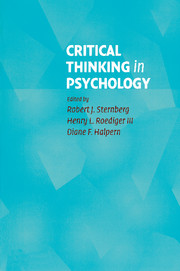Book contents
- Frontmatter
- Contents
- List of Illustrations and Tables
- List of Contributors
- Preface
- 1 The Nature and Nurture of Critical Thinking
- 2 Evaluating Experimental Research
- 3 Critical Thinking in Quasi-Experimentation
- 4 Evaluating Surveys and Questionnaires
- 5 Critical Thinking in Designing and Analyzing Research
- 6 The Case Study Perspective on Psychological Research
- 7 Informal Logical Fallacies
- 8 Designing Studies to Avoid Confounds
- 9 Evaluating Theories
- 10 Not All Experiments Are Created Equal
- 11 Making Claims in Papers and Talks
- 12 Critical Thinking in Clinical Inference
- 13 Evaluating Parapsychological Claims
- 14 Why Would Anyone Do or Believe Such a Thing?
- 15 The Belief Machine
- 16 Critical Thinking and Ethics in Psychology
- 17 Critical Thinking in Psychology
- Author Index
- Subject Index
- References
13 - Evaluating Parapsychological Claims
Published online by Cambridge University Press: 05 June 2012
- Frontmatter
- Contents
- List of Illustrations and Tables
- List of Contributors
- Preface
- 1 The Nature and Nurture of Critical Thinking
- 2 Evaluating Experimental Research
- 3 Critical Thinking in Quasi-Experimentation
- 4 Evaluating Surveys and Questionnaires
- 5 Critical Thinking in Designing and Analyzing Research
- 6 The Case Study Perspective on Psychological Research
- 7 Informal Logical Fallacies
- 8 Designing Studies to Avoid Confounds
- 9 Evaluating Theories
- 10 Not All Experiments Are Created Equal
- 11 Making Claims in Papers and Talks
- 12 Critical Thinking in Clinical Inference
- 13 Evaluating Parapsychological Claims
- 14 Why Would Anyone Do or Believe Such a Thing?
- 15 The Belief Machine
- 16 Critical Thinking and Ethics in Psychology
- 17 Critical Thinking in Psychology
- Author Index
- Subject Index
- References
Summary
Imagine that you have been assigned to evaluate a parapsychological claim. The assignment could be from a journal editor or from a media outlet. Or it could come from a granting agency or an instructor. You might be faced with such a task in your role as a referee for a professional journal. Or you might take on the assignment out of curiosity.
How would you proceed? Your first step might be to decide on the scope of the parapsychological claim. Are you dealing with a specific claim based on one experiment? Or is the claim based on evidence from a series of experiments? Perhaps you want to assess the status of the entire field of parapsychology.
What, indeed, makes a claim “parapsychological?” The term parapsychology was borrowed by J. B. Rhine to refer to what previously had been called psychical research. With the new label, Rhine wanted to promote an experimental science. Previous to Rhine, psychical research had focused on field investigations of haunted houses, tests of spiritualist mediums, surveys of premonitory dreams, and other dramatic, but controversial, paranormal claims. Rhine wanted parapsychology to focus on quantitative evidence obtained in controlled, laboratory settings. Beginning in the 1930s, parapsychologists started accumulating experimental evidence for the existence of extrasensory perception (ESP) and psychokinesis (PK). According to the glossary in the back of The Journal of Parapsychology, ESP is defined as “Experience of, or response to, a target object, state, event, or influence without sensory contact.” ESP includes telepathy, clairvoyance, and precognition.
- Type
- Chapter
- Information
- Critical Thinking in Psychology , pp. 216 - 231Publisher: Cambridge University PressPrint publication year: 2006
References
- 2
- Cited by

